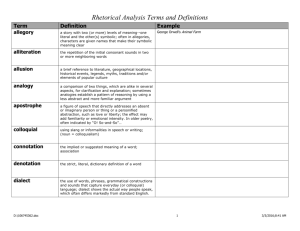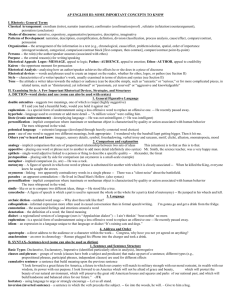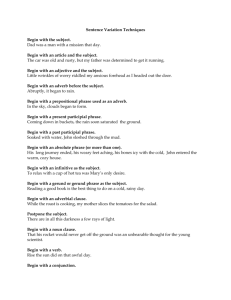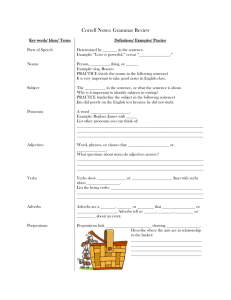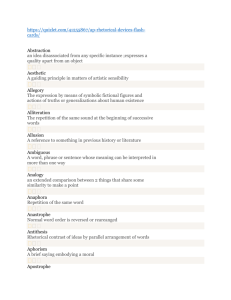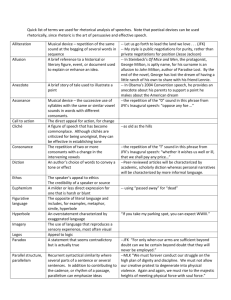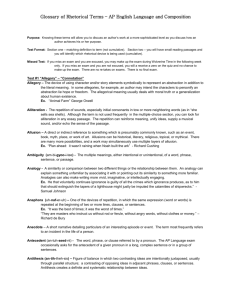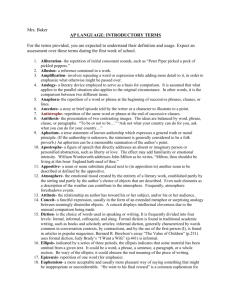Rhetorical Terms/Devices
advertisement
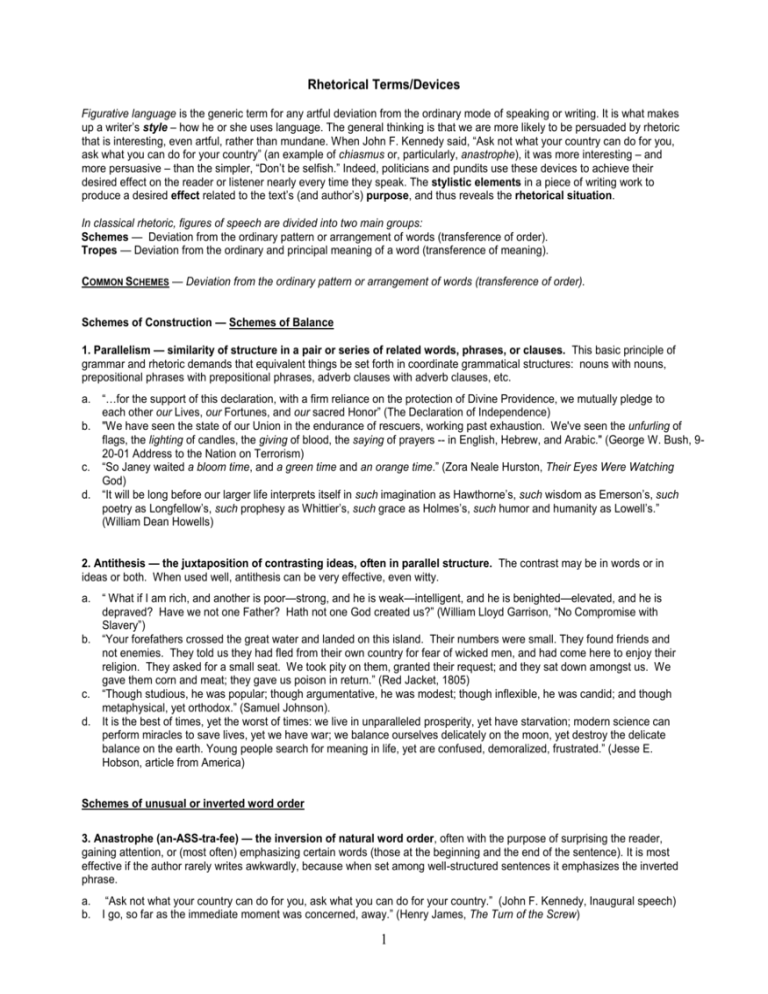
Rhetorical Terms/Devices Figurative language is the generic term for any artful deviation from the ordinary mode of speaking or writing. It is what makes up a writer’s style – how he or she uses language. The general thinking is that we are more likely to be persuaded by rhetoric that is interesting, even artful, rather than mundane. When John F. Kennedy said, “Ask not what your country can do for you, ask what you can do for your country” (an example of chiasmus or, particularly, anastrophe), it was more interesting – and more persuasive – than the simpler, “Don’t be selfish.” Indeed, politicians and pundits use these devices to achieve their desired effect on the reader or listener nearly every time they speak. The stylistic elements in a piece of writing work to produce a desired effect related to the text’s (and author’s) purpose, and thus reveals the rhetorical situation. In classical rhetoric, figures of speech are divided into two main groups: Schemes — Deviation from the ordinary pattern or arrangement of words (transference of order). Tropes — Deviation from the ordinary and principal meaning of a word (transference of meaning). COMMON SCHEMES — Deviation from the ordinary pattern or arrangement of words (transference of order). Schemes of Construction — Schemes of Balance 1. Parallelism — similarity of structure in a pair or series of related words, phrases, or clauses. This basic principle of grammar and rhetoric demands that equivalent things be set forth in coordinate grammatical structures: nouns with nouns, prepositional phrases with prepositional phrases, adverb clauses with adverb clauses, etc. a. b. c. d. “…for the support of this declaration, with a firm reliance on the protection of Divine Providence, we mutually pledge to each other our Lives, our Fortunes, and our sacred Honor” (The Declaration of Independence) "We have seen the state of our Union in the endurance of rescuers, working past exhaustion. We've seen the unfurling of flags, the lighting of candles, the giving of blood, the saying of prayers -- in English, Hebrew, and Arabic." (George W. Bush, 920-01 Address to the Nation on Terrorism) “So Janey waited a bloom time, and a green time and an orange time.” (Zora Neale Hurston, Their Eyes Were Watching God) “It will be long before our larger life interprets itself in such imagination as Hawthorne’s, such wisdom as Emerson’s, such poetry as Longfellow’s, such prophesy as Whittier’s, such grace as Holmes’s, such humor and humanity as Lowell’s.” (William Dean Howells) 2. Antithesis — the juxtaposition of contrasting ideas, often in parallel structure. The contrast may be in words or in ideas or both. When used well, antithesis can be very effective, even witty. a. b. c. d. “ What if I am rich, and another is poor—strong, and he is weak—intelligent, and he is benighted—elevated, and he is depraved? Have we not one Father? Hath not one God created us?” (William Lloyd Garrison, “No Compromise with Slavery”) “Your forefathers crossed the great water and landed on this island. Their numbers were small. They found friends and not enemies. They told us they had fled from their own country for fear of wicked men, and had come here to enjoy their religion. They asked for a small seat. We took pity on them, granted their request; and they sat down amongst us. We gave them corn and meat; they gave us poison in return.” (Red Jacket, 1805) “Though studious, he was popular; though argumentative, he was modest; though inflexible, he was candid; and though metaphysical, yet orthodox.” (Samuel Johnson). It is the best of times, yet the worst of times: we live in unparalleled prosperity, yet have starvation; modern science can perform miracles to save lives, yet we have war; we balance ourselves delicately on the moon, yet destroy the delicate balance on the earth. Young people search for meaning in life, yet are confused, demoralized, frustrated.” (Jesse E. Hobson, article from America) Schemes of unusual or inverted word order 3. Anastrophe (an-ASS-tra-fee) — the inversion of natural word order, often with the purpose of surprising the reader, gaining attention, or (most often) emphasizing certain words (those at the beginning and the end of the sentence). It is most effective if the author rarely writes awkwardly, because when set among well-structured sentences it emphasizes the inverted phrase. a. b. “Ask not what your country can do for you, ask what you can do for your country.” (John F. Kennedy, Inaugural speech) I go, so far as the immediate moment was concerned, away.” (Henry James, The Turn of the Screw) 1 c. “One ad does not a survey make.” (caption from an ad for Peugot automobiles) 4. Parenthesis — insertion of some verbal unit in a position that interrupts the normal syntactical flow of the sentence, thereby sending the thought off on an important tangent that has pronounced rhetorical effect. Often involves literal parentheses ( ), but not always; there are other ways to insert a comment into a sentence. One might use commas, or dashes, for example. The parenthetical remark, however, is off on a tangent, cut off from the thrust of the sentence and grammatically unrelated to the sentence. a. b. c. d. “Those two spots are among the darkest of our whole civilization—pardon me, our whole culture (an important distinction, I’ve heard), which might sound like a hoax, or a contradiction, but that (by contradiction, I mean) is how the world moves: not like an arrow, but a boomerang.” (Ralph Ellison, Invisible Man) “And they went further and further from her, being attached to her by a thin thread (since they had lunched with her) which would stretch and stretch, get thinner and thinner as they walked across London; as if one’s friends were attached to one’s body, after lunching with them, by a thin thread, which (as she dozed there) became hazy with the sound of bells, striking the hour or ringing to service, as a single spider’s thread is blotted with rain-drops, and burdened, sags down. So she slept.”—Virginia Woolf, Mrs. Dalloway “He said he supervised ten editors––another euphemism––in his department, which clears 90% of NBC’s entertainment programming…” (Joan Barthel, in Life magazine, August 1969) “There is even, and it is the achievement of this book, a curious sense of happiness running through its paragraphs.” (Norman Mailer, book review) Schemes of Omission 5. Ellipsis - deliberate omission of a word or of words that are readily implied by the context and must be supplied by the reader or listener. While this can make clear, economical sentences, if the understood words are grammatically incompatible, the resulting sentence may be awkward. a. b. c. “So singularly clear was the water that when it was only twenty or thirty feet deep the bottom seemed floating on the air! Yes, where it was even eighty feet deep. Every little pebble was distinct, every speckled trout, every hand’s breadth of sand.” (Mark Twain, Roughing It) “And he to England shall along with you.” (Shakespeare, Hamlet III,iii) "Twenty-two years old, weak, hot, frightened, not daring to acknowledge the fact that he didn't know who or what he was…with no past, no language, no tribe, no source, no address book, no comb, no pencil, no clock, no pocket handkerchief, no rug, no bed, no can opener, no faded postcard, no soap, no key, no tobacco pouch, no soiled underwear and nothing nothing nothing to do…he was sure of one thing only: the unchecked monstrosity of his hands." (Toni Morrison, Sula) 6. Asyndeton ( a SIN da ton) — deliberate omission of conjunctions between a series of words, phrases, or clauses. The effects of this device are to emphasize each clause and to produce a punctuated rhythm in the sentence. a. b. c. “I came, I saw, I conquered.” (Julius Caesar) "Dogs, undistinguishable in mire. Horses, scarcely better--splashed to their very blinkers. Foot passengers, jostling one another's umbrellas, in a general infection of ill temper . . .." (Charles Dickens, Bleak House) “...that we shall pay any price, bear any burden, meet any hardship, support any friend, oppose any foe to assure the survival and the success of liberty. “ (John F. Kennedy) 7. Polysyndeton — deliberate use of many conjunctions (does not involve omission, but is grouped with its opposite, asyndeton)). The effect of polysyndeton is to speed up or add a frenetic quality to the rhythm of the sentence. a. b. c. “I said, ‘Who killed him?’ and he said, ‘I don’t know who killed him but he’s dead all right,’ and it was dark and there was water standing in the street and no lights and windows broke and boats all up in the town and trees blown down and everything all blown and I got a skiff and went out and found my boat where I had her inside Mango Key and she was all right only she was full of water.” (Ernest Hemingway, “After the Storm”) “On and on she went, across Piccadilly, and up Regent Street, ahead of him, her cloak, her gloves, her shoulders combining with the fringes and the laces and the feather boas in the windows to make the spirit of finery and whimsy which dwindled out of the shops on to the pavement, as the light of a lamp goes wavering at night over hedges in the darkness.” (Virginia Woolf, Mrs. Dalloway) "We lived and laughed and loved and left." (James Joyce, Finnegans Wake) Schemes of Repetition 8. Alliteration — repetition of initial or medial consonants in two or more adjacent words. Used sparingly, alliteration provides emphasis. Overused, it sounds silly. 2 a. b. c. d. "Somewhere at this very moment a child is being born in America. Let it be our cause to give that child a happy home, a healthy family, and a hopeful future." (Bill Clinton, 1992 DNC Acceptance Address) “It was the meanest moment of eternity”. (Zora Neale Hurston, Their Eyes Were Watching God) "Guinness is good for you." (advertisement) "My style is public negotiations for parity, rather than private negotiations for position." (Jesse Jackson) 9. Assonance - the repetition of similar vowel sounds, preceded and followed by different consonants, in the stressed syllables of adjacent words. “Whales in the wake like capes and Alps/ Quaked the sick sea and snouted deep.” (Dylan Thomas, “Ballad of the Long Legged Bait”) b. “Refresh your zest for living.” (advertisement for French Line Ships) c. "Strips of tinfoil winking like people." (Sylvia Plath) d. "The gloves didn't fit. If it doesn't fit, you must acquit." (Johnny Cochran, O.J.Simpson trial) a. 10. Anaphora — repetition of the same word or groups of words at the beginnings of successive phrases. This device produces a strong emotional effect, especially in speech. It also establishes a marked change in rhythm. a. b. c. "We shall not flag or fail. We shall go on to the end. We shall fight in France, we shall fight on the seas and oceans, we shall fight with growing confidence and growing strength in the air, we shall defend our island . . . we shall never surrender." (Winston Churchill, 1940) “Why should white people be running all the stores in our community? Why should white people be running the banks of our community? Why should the economy of our community be in the hands of the white man? Why?” (Malcolm X) "Yesterday, the Japanese government also launched an attack against Malaya. Last night, Japanese forces attacked Hong Kong. Last night, Japanese forces attacked Guam. Last night, Japanese forces attacked the Philippine Islands. Last night, the Japanese attacked Wake Island. And this morning, the Japanese attacked Midway Island." (Franklin Roosevelt, Pearl Harbor Address) 11. Epistrophe — repetition of the same word or group of words at the ends of successive phrases. Like anaphora, epistrophe produces a strong rhythm and emphasis. a. b. c. d. “But to all of those who would be tempted by weakness, let us leave no doubt that we will be as strong as we need to be for as long as we need to be.” (Richard Nixon, First Inaugural Address) "...and that government of the people, by the people, for the people shall not perish from the earth." (Abraham Lincoln, Gettysburg Address) “As long as the white man sent you to Korea, you bled. He sent you to Germany, you bled. He sent you to the South Pacific to fight the Japanese, you bled.” (Speech by Malcolm X) “In a cake, nothing tastes like real butter, nothing moistens like real butter, nothing enriches like real butter, nothing satisfies like real butter.” (Caption from a Pillsbury ad) 12. Epanalepsis (eh-puh-nuh-LEAP-siss) — repetition of the same word or words at both beginning and ending of a phrase, clause, or sentence. Like other schemes of repetition, epanalepsis often produces or expresses strong emotion. a. b. c. Blood hath bought blood, and blows have answer’d blows:/ Strength match’d with strength, and power confronted power. (William Shakespeare, King John) “Nothing is worse than doing nothing.” "A minimum wage that is not a livable wage can never be a minimum wage." (Ralph Nader) 13. Climax — arrangement of words, phrases, or clauses in an order of increasing importance. a. “More than that, we rejoice in our sufferings, knowing that suffering produces endurance, endurance produces character, and character produces hope, and hope does not disappoint us, because God’s love has been poured into our hearts through the Holy Spirit which has been given to use.” (St. Paul, Romans) b. "And from the crew of Apollo 8, we close with good night, good luck, a merry Christmas, and God bless all of you, all of you on the good earth." (Frank Borman, astronaut) c. “Miss America was not so much interested in serving herself as she was eager to serve her family, her community, and her nation.” 14. Chiasmus (ki-AS-mus) – (the “criss-cross”) — reversal of grammatical structures in successive phrases or clauses. Chiasmus is similar to antimetabole in that it too involves a reversal of grammatical structures in successive phrases or clauses, but it is unlike antimetabole in that it does not involve a repetition of words. Both chiasmus and antimetabole can be used to reinforce antithesis. a. “Exalts his enemies, his friends destroys.” (John Dryden, “Absalom and Achitophel”) 3 b. “It is boring to eat; to sleep is fulfilling.” COMMON TROPES — Deviation from the ordinary and principal meaning of a word (transference of meaning). 15. Metaphor - implied comparison between two things of unlike nature a. “The symbol of all our aspirations, one of the student leaders called her: the fruit of our struggle.” (John Simpson, “Tianamen Square”) b. “A breeze blew through the room, blue curtains in at one end and out the other…twisting them up toward the frosted wedding-cake of a ceiling, and then rippled over the wine-colored rug, making a shadow on it…. –F. Scott Fitzgerald, The Great Gatsby c. "With this faith we will be able to transform the jangling discords of our nation into a beautiful symphony of brotherhood." (Martin Luther King, I Have a Dream) 16. Simile - explicit comparison between two things of unlike nature, usually using “like” or “as” a. “The night is bleeding like a cut.” (Bono) b. “Ah my!” said Eustacia, with a laugh which unclosed her lips so that the sun shone into her mouth as into a tulip and lent it a similar scarlet fire.” (Thomas Hardy, The Return of the Native) 17. Synecdoche (sih-NECK-duh-kee) — figure of speech in which a part stands for the whole a. “I have nothing to offer but blood, toil, tears, and sweat.” (Winston Churchill, 1940) b. “In Europe, we gave the cold shoulder to De Gaulle, and now he gives the warm hand to Mao Tse-tung.” (Richard Nixon, 1960) c. “Give us this day our daily bread.” (Matthew, 6:11) 18. Metonymy (me-TON-y-my) – substitution of some attributive or suggestive word for what is actually meant. a. The British crown has been plagued by scandal. b. There is no word from the Pentagon on the new rumors from Afghanistan. c. The pen is mightier than the sword. 19. Personification — investing abstractions or inanimate objects with human qualities a. b. “The night comes crawling in on all fours.” (David Lowery) "Once again, the heart of America is heavy. The spirit of America weeps for a tragedy that denies the very meaning of our land." (Lyndon Baines Johnson) 20. Hyperbole — the use of exaggerated terms for the purpose of emphasis or heightened effect. a. b. “It rained for four years, eleven months, and two days.” (Gabriel Garcia Marquez, One Hundred Years of Solitude) “We walked along a road in Cumberland and stooped, because the sky hung so low.” (Thomas Wolfe, Look Homeward, Angel) 21. Litotes (LI-tuh-tees OR lie-TOE-tees) — deliberate use of understatement a. “Last week I saw a woman flayed, and you will hardly believe how much it altered her appearance for the worse.” (Jonathan Swift, A Tale of a Tub) b. “It isn’t very serious. I have this tiny little tumor on the brain.” (Catcher in the Rye) c. “For four generations we’ve been making medicines as if people’s lives depended on them.” (Ad for Eli Lilly Drug Company 22. Rhetorical question - asking a question, not for the purpose of eliciting an answer but to assert or deny an answer implicitly a. b. c. “Isn’t it interesting that this person to whom you set on your knees in your most private sessions at night and you pray, doesn’t even look like you?” (Malcolm X) “Can anyone look at our reduced standing in the world today and say, ‘Let's have four more years of this’? (Ronald Reagan, 1980 RNC Acceptance Address) "Sir, at long last, have you left no sense of decency?" (Joseph Welch, The Army-McCarthy Hearings) *23. Irony — use of a word in such a way as to convey a meaning opposite to the literal meaning of the word a. “This plan means that one generation pays for another. Now that’s just dandy.” (Huey P. Long) b. “By Spring, if God was good, all the proud privileges of trench lice, mustard gas, spattered brains, punctured lungs, ripped guts, asphyxiation, mud and gangrene might be his.” (Thomas Wolfe, Look Homeward Angel) (1) verbal irony – when the words literally state the opposite of the writer’s (or speaker’s) meaning 4 (2) situational irony – when events turn out the opposite of what was expected; when what the characters and readers think ought to happen is not what does happen (3) dramatic irony – when facts or events are unknown to a character in a play or piece of fiction but known to the reader, audience, or other characters in the work. 24. Onomatapoeia — use of words whose sound echoes the sense a. “Snap, crackle, pop!” (Rice Krispies commercial) b. “…From the clamor and the clangor of the bells!” (Edgar Allan Poe, “The Bells”) 25. Oxymoron — the joining of two terms which are ordinarily contradictory a. “The unheard sounds came through, each melodic line existed of itself, stood out clearly from all the rest, said its piece, and waiting patiently for the other voices to speak.” --Ralph Ellison, Invisible Man b. “cruel kindness”; “visible darkness” 26. Paradox — an apparently contradictory statement that nevertheless contains a measure of truth a. b. c. “And yet, it was a strangely satisfying experience for an invisible man to hear the silence of sound.” (Ralph Ellison, Invisible Man) “Art is a form of lying in order to tell the truth.” (Pablo Picasso) “Whoever loses his life, shall find it.” (Matthew, 16:25) Other Literary Analysis Terms useful for the AP English Language Test *27. allegory – The device of using character and/or story elements symbolically to represent an abstraction in addition to the literal meaning. In some allegories, for example, an author may intend the characters to personify an abstraction like hope or freedom. The allegorical meaning usually deals with moral truth or a generalization about human existence. Example: Orwell’s Animal Farm is an allegory on the brutality and dishonesty of the Soviet communist system. 28. allusion – A direct or indirect reference to something which is presumably commonly known, such as an event, book, myth, place, or work of art. Allusions can be historical, literary, religious, topical, or mythical. There are many more possibilities, and a work may simultaneously use multiple layers of allusion. Example: He was destined to fail; he always flew too close to the sun. (An allusion to the Greek myth Icarus.) 29. analogy – A similarity or comparison between two different things or the relationship between them. An analogy can explain something unfamiliar by associating it with or pointing out its similarity to something more familiar. Analogies can also make writing more vivid, imaginative, or intellectually engaging. Example: Getting politicians to agree is like herding cats.” (Beware the logical fallacy of the false or weak analogy, in which the two things being compared are so dissimilar the comparison makes little sense or becomes absurd. Example: Voting against affirmative action is like voting for slavery.) 30. antecedent – The word, phrase, or clause referred to by a pronoun. The AP language exam occasionally asks for the antecedent of a given pronoun in a long, complex sentence or in a group of sentences. A question from the 2001 AP test as an example follows: “But it is the grandeur of all truth which can occupy a very high place in human interests that it is never absolutely novel to the meanest of minds; it exists eternally, by way of germ of latent principle, in the lowest as in the highest, needing to be developed but never to be planted.” The antecedent of “it” (bolded) is...? [answer: “all truth”] 31. aphorism – A terse statement of known authorship which expresses a general truth or a moral principle. (If the authorship is unknown, the statement is generally considered to be a folk proverb.) An aphorism can be a memorable summation of the author’s point. “A lie told often enough becomes the truth.” ~ Vladimir Lenin (Note: For vocabulary assignment you may use aphorisms that are not your own work.) 32. caricature – A verbal description, the purpose of which is to exaggerate or distort, for comic effect or ridicule, a person’s distinctive physical features or other characteristics. 33. clause – A grammatical unit that contains both a subject and a verb. An independent, or main, clause expresses a complete thought and can stand alone as a sentence. A dependent, or subordinate clause, cannot stand alone as a sentence and must be accompanied by an independent clause. The point that you want to consider is the question of what or why the author subordinates one element, and you should also become aware of making effective use of subordination in your own writing. 5 34. colloquial/colloquialism – The use of slang or informalities in speech or writing. Not generally acceptable for formal writing, colloquialisms give a work a conversational, familiar tone. Colloquial expressions in writing include local or regional dialects. *35. conceit – A fanciful expression, usually in the form of an extended metaphor or surprising analogy between seemingly dissimilar objects, usually used in poetry. A conceit displays intellectual cleverness as a result of the unusual comparison being made, as in Shakespeare’s Sonnet 18: Shall I compare thee to a summer’s day?/Thou art more lovely and more temperate.” *36. diction — Related to style, diction refers to the writer’s word choices, especially with regard to their correctness, clearness, or effectiveness. For the AP exam, you should be able to describe an author’s diction (for example, formal or informal, ornate or plain) and understand the ways in which diction can complement the author’s purpose. Diction, combined with syntax, figurative language, literary devices, etc., creates an author’s style. Denotation — The strict, literal, dictionary definition of a word, devoid of any emotion, attitude, or color. (Example: the denotation of a knife would be a utensil used to cut) Connotation — The non-literal, associative meaning of a word; the implied, suggested meaning. Connotations may involve ideas, emotions, or attitudes (the connotation of a knife might be fear, violence, anger, foreboding, etc.) *37. ethos — In writing and speaking, a persuasive appeal to the audience based on the credibility, good character, etc., of the speaker/writer. 38. euphemism – From the Greek for “good speech,” euphemisms are a more agreeable or less offensive substitute for a generally unpleasant word or concept. The euphemism may be used to adhere to standards of social or political correctness or to add humor or ironic understatement. Saying “earthly remains” rather than “corpse” is an example of euphemism. *39. extended metaphor – A metaphor developed at great length, occurring frequently in or throughout a work. *40. Imagery — The sensory details or figurative language used to describe, arouse emotion, or represent abstractions. On a physical level, imagery uses terms related to the five senses: visual, auditory, tactile, gustatory, and olfactory. On a broader and deeper level, however, one image can represent more than one thing. For example, a rose may present visual imagery while also representing the color in a woman’s cheeks and/or symbolizing some degree of perfection. An author may use complex imagery while simultaneously employing other figures of speech, especially metaphor and simile. In addition, this term can apply to the total of all the images in a work. On the AP language exam, pay attention to how an author creates imagery and to the effect of this imagery. *41. Inference/infer – To draw a reasonable conclusion from the information presented. When a multiple choice question asks for an inference to be drawn from a passage, the most direct, most reasonable inference is the safest answer choice. If an inference is implausible, it’s unlikely to be the correct answer.. *42. logos — In writing and speaking, a persuasive appeal to the audience based on logic and reason. *43. mood – The prevailing atmosphere or emotional aura of a work. Setting, tone, and events can affect the mood. Mood is similar to tone and atmosphere. *44. narrative – The telling of a story or an account of an event or series of events. In political speech, also used to suggest the “story-line” a politician wants people to hear: “The President tried to push a narrative that he was raising taxes to help people.” *45. parody – A work that closely imitates the style or content of another with the specific aim of comic effect and/or ridicule. It exploits peculiarities of an author’s expression (propensity to use too many parentheses, certain favorite words, etc.). Well-written parody offers enlightenment about the original, but poorly written parody offers only ineffectual imitation. Usually an audience must grasp literary allusion and understand the work being parodied in order to fully appreciate the nuances of the newer work. Occasionally, however, parodies take on a life of their own and don’t require knowledge of the original. *46. pathos — In writing and speaking, a persuasive appeal to the audience based on emotion. *47. prose – One of the major divisions of genre, prose refers to fiction and nonfiction, including all its forms. In prose the printer determines the length of the line; in poetry, the poet determines the length of the line. 6 48. point of view – In literature, the perspective from which a story is told. There are two general divisions of point of view, and many subdivisions within those. (1) first person narrator tells the story with the first person pronoun, “I,” and is a character in the story. This narrator can be the protagonist, a secondary character, or an observing character. (2) third person narrator relates the events with the third person pronouns, “he,” “she,” and “it.” There are two main subdivisions to be aware of: a. third person omniscient, in which the narrator, with godlike knowledge, presents the thoughts and actions of any or all characters. b. third person limited omniscient, in which the narrator presents the feelings and thoughts of only one character, presenting only the actions of all the remaining characters. In addition, be aware that the term point of view carries an additional meaning. When you are asked to analyze the author’s point of view, the appropriate point for you to address is the author’s attitude. *49. repetition – The duplication, either exact or approximate, of any element of language, such as a sound, word, phrase, clause, sentence, or grammatical pattern. *50. rhetoric – From the Greek for “orator,” this term describes the principles governing the art of writing effectively, eloquently, and persuasively. *51. rhetorical modes – This flexible term describes the variety, the conventions, and the purposes of the major kinds of writing. The four most common rhetorical modes (often referred to as “modes of discourse”) are as follows: (1) The purpose of exposition (or expository writing) is to explain and analyze information by presenting an idea, relevant evidence, and appropriate discussion. The AP language exam essay questions are frequently expository topics. (2) The purpose of argumentation is to prove the validity of an idea, or point of view, by presenting sound reasoning, discussion, and argument that thoroughly convince the reader. Persuasive writing is a type of argumentation having an additional aim of urging some form of action. (3) The purpose of description is to recreate, invent, or visually present a person, place, event or action so that the reader can picture that being described. Sometimes an author engages all five senses in description; good descriptive writing can be sensuous and picturesque. Descriptive writing may be straightforward and objective or highly emotional and subjective. (4) The purpose of narration is to tell a story or narrate an event or series of events. This writing mode frequently uses the tools of descriptive writing. 52. sarcasm – From the Greek meaning “to tear flesh,” sarcasm involves bitter, caustic language that is meant to hurt or ridicule someone or something. It may use irony as a device, but not all ironic statements are sarcastic (that is, intended to ridicule). When well done, sarcasm can be witty and insightful; when poorly done, it is simply cruel. *53. satire – A work that targets human vices and follies or social institutions and conventions for reform or ridicule. Regardless of whether or not the work aims to reform human behavior, satire is best seen as a style of writing rather than a purpose for writing. It can be recognized by the many devices used effectively by the satirist: irony, wit, parody, caricature, hyperbole, understatement, and sarcasm. The effects of satire are varied, depending on the writer’s goal, but good satire, often humorous, is thought provoking and insightful about the human condition. *54. style – The consideration of style has two purposes: (1) An evaluation of the sum of the choices an author makes in blending diction, syntax, figurative language, and other literary devices. Some authors’ styles are so idiosyncratic that we can quickly recognize works by the same author. We can analyze and describe an author’s personal style and make judgments on how appropriate it is to the author’s purpose. Styles can be called flowery, explicit, succinct, rambling, bombastic, commonplace, incisive, laconic, etc. (2) Classification of authors to a group and comparison of an author to similar authors. By means of such classification and comparison, we can see how an author’s style reflects and helps to define a historical period, such as the Renaissance or the Victorian period, or a literary movement, such as the romantic, transcendental, or realist movements. *55. symbol/symbolism – Generally, anything that represents itself and stands for something else. Usually a symbol is something concrete -- such as an object, action, character, or scene – that represents something more abstract. However, symbols and symbolism can be much more complex. One system classifies symbols into three categories: (1) natural symbols are objects and occurrences from nature to symbolize ideas commonly associated with them (dawn symbolizing hope or a new beginning, a rose symbolizing love, a tree symbolizing knowledge). (2) conventional symbols are those that have been invested with meaning by a group (religious symbols such as a cross or Star of David; national symbols, such as a flag or an eagle; or group symbols, such as a skull and crossbones for pirates or the scale of justice for lawyers). 7 (3) literary symbols are sometimes also conventional in the sense that they are found in a variety of works and are more generally recognized. However, a work’s symbols may be more complicated. On the AP exam, try to determine what abstraction an object is a symbol for and to what extent it is successful in representing that abstraction. 56. syntax – The way an author chooses to join words into phrases, clauses, and sentences. Syntax is similar to diction, but you can differentiate them by thinking of syntax as groups of words, while diction refers to the individual words. In the multiple-choice section of the AP exam, expect to be asked some questions about how an author manipulates syntax. In the essay section, you will need to analyze how syntax produces effects. *57. theme – The central idea or message of a work, the insight it offers into life. Usually theme is unstated in fictional works, but in nonfiction, the theme may be directly state, especially in expository or argumentative writing. *58. thesis – In expository writing, the thesis statement is the sentence or group of sentences that directly expresses the author’s opinion, purpose, meaning, or position. Expository writing is usually judged by analyzing how accurately, effectively, and thoroughly a writer has proven the thesis. *59. tone – Similar to mood, tone describes the author’s attitude toward his material, the audience, or both. Tone is easier to determine in spoken language than in written language. Considering how a work would sound if it were read aloud can help in identifying an author’s tone. Some words describing tone are playful, serious, businesslike, sarcastic, humorous, formal, ornate, sardonic, somber, etc. 60. transition – A word or phrase that links different ideas. Used especially, although not exclusively, in expository and argumentative writing, transitions effectively signal a shift from one idea to another. A few commonly used transitional words or phrases are furthermore, consequently, nevertheless, for example, in addition, likewise, similarly, on the contrary, etc. More sophisticated writers use more subtle means of transition. *61. understatement – The ironic minimalizing of fact, understatement presents something as less significant than it is. The effect can frequently be humorous and emphatic. Understatement is the opposite of hyperbole. Example: Jonathan Swift’s A Tale of a Tub: “Last week I saw a woman flayed, and you will hardly believe how much it altered her person for the worse.” 8
